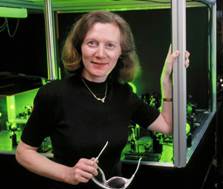Dr Margaret Murnane explores the many capabilities and potential applications of tabletop high-harmonic light sources.
Read more- Home
- Semester and Timetable Information
- Study Physics
- Our Research
- Our People
- Careers and Alumni
- Seminars, News and Events
- Outreach and School Resources
- About the School
- What is Physics
- The Crawford Observatory
- Frequently Asked Questions
- MBH Conference
- UCC Futures Quantum & Photonics
- Supports
Seminars 2020/2021
19th April 2021
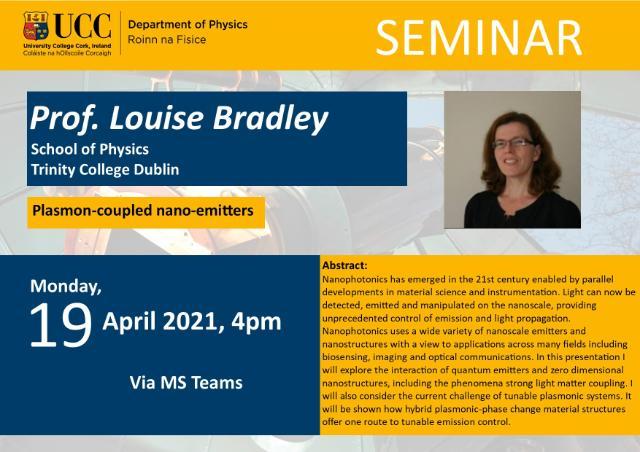
| Seminar Speaker: |
Professor Louise Bradley (School of Physics, Trinity College Dublin) |
| Venue: | |
| Date and Time: | Monday, 19th April 2021, 4pm |
| Seminar Title: | Plasmon-coupled nano-emitters |
| Abstract:
|
|
29th March 2021
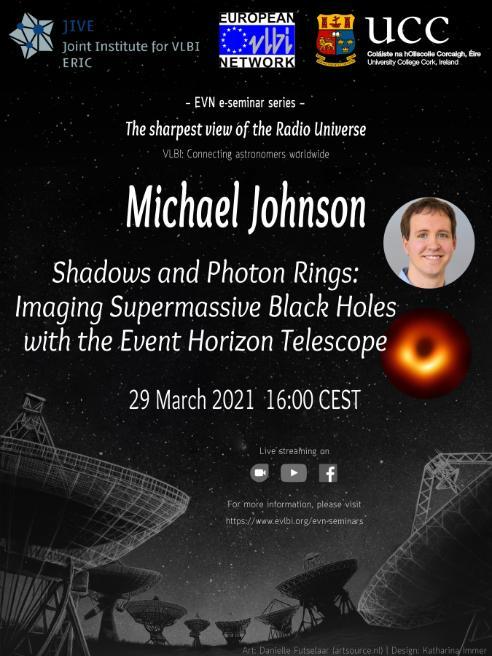
| Seminar Speaker: |
Michael Johnson (Harvard-Smithsonian Center for Astrophysics) |
| Venue: | Online via Zoom: (Meeting ID:885 4531 2932) The talk will also be streamed in real time via YouTube in the JIVE and EVN channel: https://youtu.be/YfPK1mHAdP0 |
| Date and Time: | Monday, 29th March 2021, 3pm (Irish Time) |
| Seminar Title: | Shadows and Photon Rings: Imaging Supermassive Black Holes with the Event Horizon Telescope |
| Abstract:
|
|
22nd March 2021
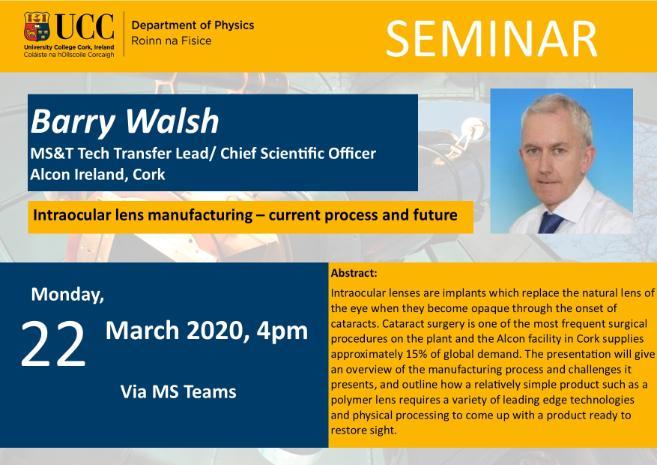
| Seminar Speaker: |
Barry Walsh (MS&T Tech Transfer Lead/ Chief Scientific Officer, Alcon Ireland, Cork) |
| Venue: | |
| Date and Time: | Monday, 22nd March 2021, 4pm |
| Seminar Title: | Intraocular lens manufacturing – current process and future challenges |
| Abstract: |
|
1st March 2021
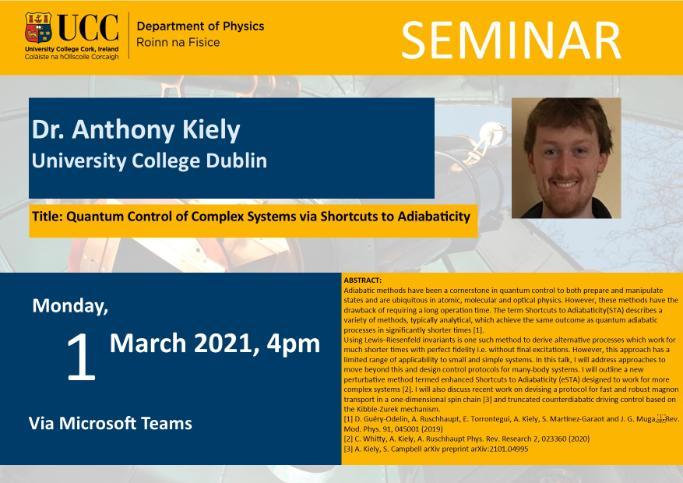
| Seminar Speaker: |
Dr. Anthony Kiely (University College Dublin) |
| Venue: | |
| Date and Time: | Monday, 1st March 2021, 4pm |
| Seminar Title: | Quantum Control of Complex Systems via Shortcuts to Adiabaticity |
| Abstract: Using Lewis–Riesenfeld invariants is one such method to derive alternative processes which work for much shorter times with perfect fidelity i.e. without final excitations. However, this approach has a limited range of applicability to small and simple systems. In this talk, I will address approaches to move beyond this and design control protocols for many-body systems. I will outline a new perturbative method termed enhanced Shortcuts to Adiabaticity (eSTA) designed to work for more complex systems [2]. I will also discuss recent work on devising a protocol for fast and robust magnon transport in a one-dimensional spin chain [3] and truncated counterdiabatic driving control based on the Kibble-Zurek mechanism. |
|
22nd February 2021
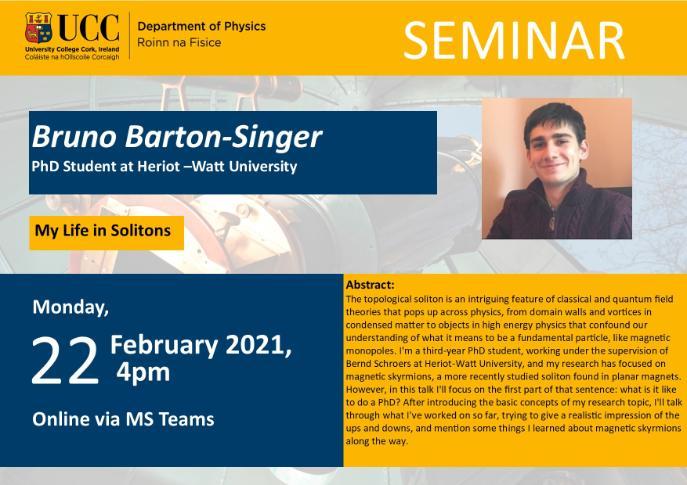
Note: This seminar gives an idea of what PhD life is like, with the research as the secondary emphasis.
| Seminar Speaker: |
Bruno Barton-Singer (PhD student, supervised by Bernd Schroers at Heriot-Watt University) |
| Venue: | |
| Date and Time: | Monday, 22nd February 2021, 4pm |
| Seminar Title: | My Life in Solitons |
| Abstract: |
|
5th February 2021
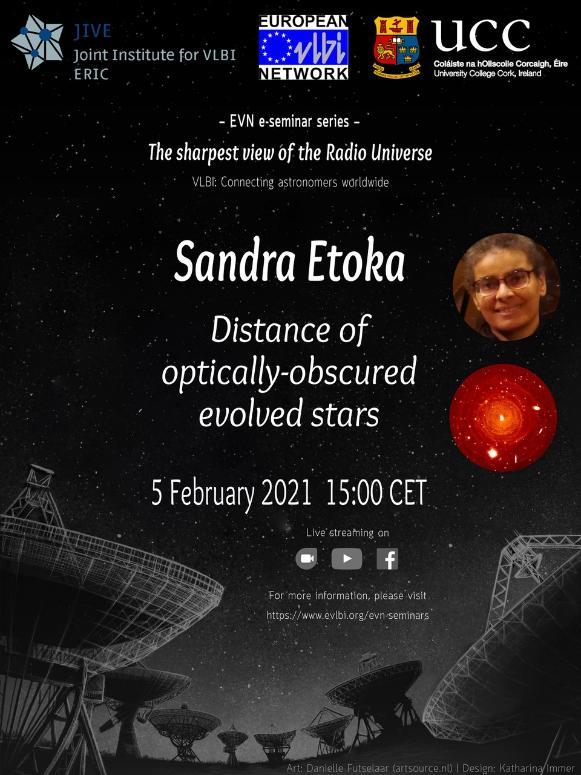
| Seminar Speaker: |
Dr. Sandra Etoka (Jodrell Bank Centre for Astrophysics & University of Manchester) |
| Venue: | Online via Zoom: (Meeting ID: 885 4531 2932) |
| Date and Time: | Friday, 5th February 2021, 2pm (Irish Time) |
| Seminar Title: | Distance of optically-obscured evolved stars |
| Abstract: Since optically thick, measurements of their distances using optical parallaxes as e.g. delivered by GAIA, is not possible. This issue can be circumvented thanks to maser emission. As their name gives it away, the physical conditions turn out to be ideal for a strong (1612-MHz) OH maser emission to be produced in the outer layers of the radially-expanding spherical circumstellar envelope of OH/IR stars. I will present how, combining single-dish monitoring and interferometric mapping of this OH maser emission, the "phase-lag method" allows us to measure their distance. |
|
1st February 2021
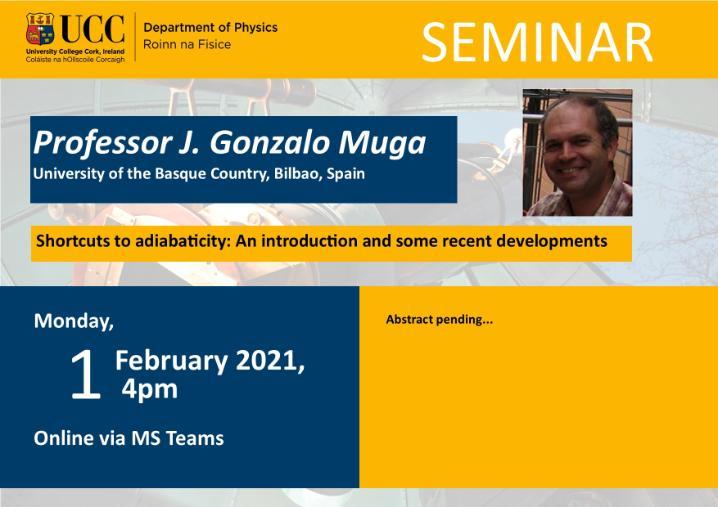
| Seminar Speaker: |
Prof. J. Gonzalo Muga (University of the Basque Country, Bilbao, Spain) |
| Venue: | |
| Date and Time: | 1st February 2021, 4pm (Irish Time) |
| Seminar Title: | Shortcuts to adiabaticity: An introduction and some recent developments |
| Abstract Pending... |
|
9th December 2020
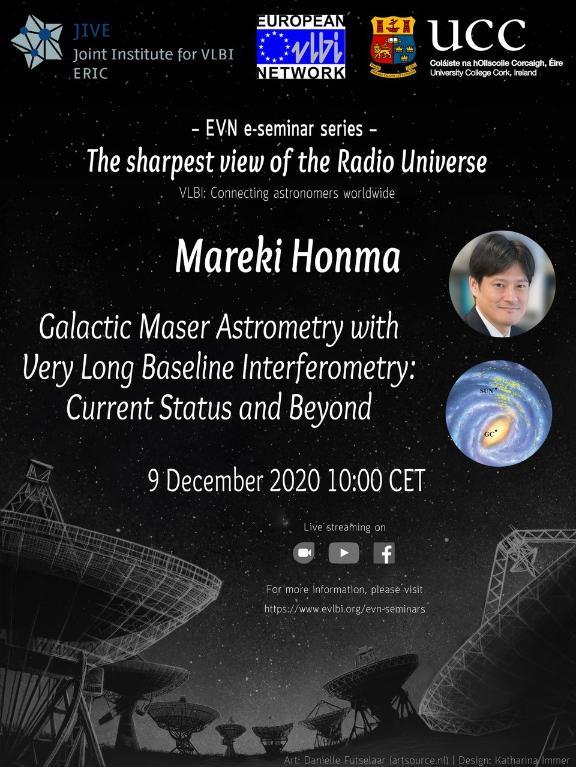
| Seminar Speaker: |
Mareki Honma |
| Venue: | Online via Zoom https://astron.zoom.us/j/88545312932 (Meeting ID: 885 4531 2932) Also streamed in real time via YouTube https://www.youtube.com/watch?v=QfTzWtxU8ZI&feature=youtu.be |
| Date and Time: | 9th December 2020, 9am (Irish Time) |
| Seminar Title: | The sharpest view of the Radio Universe |
| Abstract: |
|
7th December 2020
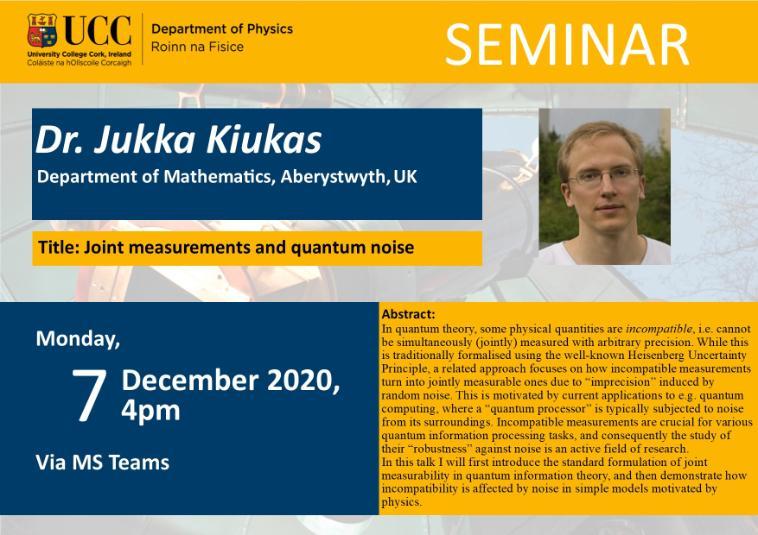
| Seminar Speaker: | Dr. Jukka Kiukas |
| Venue: | Online via MS Teams https://teams.microsoft.com/l/meetup-join/19%3ameeting_MmY0M2ZjYWYtMzc2MS00YTYwLTkxMjUtMDY2OTAzMDk2NjU2%40thread.v2/0?context=%7b%22Tid%22%3a%2246fe5ca5-866f-4e42-92e9-ed8786245545%22%2c%22Oid%22%3a%22a1fc07ee-e1f8-4e7c-b82b-0e9f830a651d%22%7d |
| Date and Time: | 7th December 2020, 4pm |
| Seminar Title: | Joint measurements and quantum noise |
| Abstract: In quantum theory, some physical quantities are incompatible, i.e. cannot be simultaneously (jointly) measured with arbitrary precision. While this is traditionally formalised using the well-known Heisenberg Uncertainty Principle, a related approach focuses on how incompatible measurements turn into jointly measurable ones due to “imprecision” induced by random noise. This is motivated by current applications to e.g. quantum computing, where a “quantum processor” is typically subjected to noise from its surroundings. Incompatible measurements are crucial for various quantum information processing tasks, and consequently the study of their “robustness” against noise is an active field of research. In this talk I will first introduce the standard formulation of joint measurability in quantum information theory, and then demonstrate how incompatibility is affected by noise in simple models motivated by physics. |
|
30th November 2020
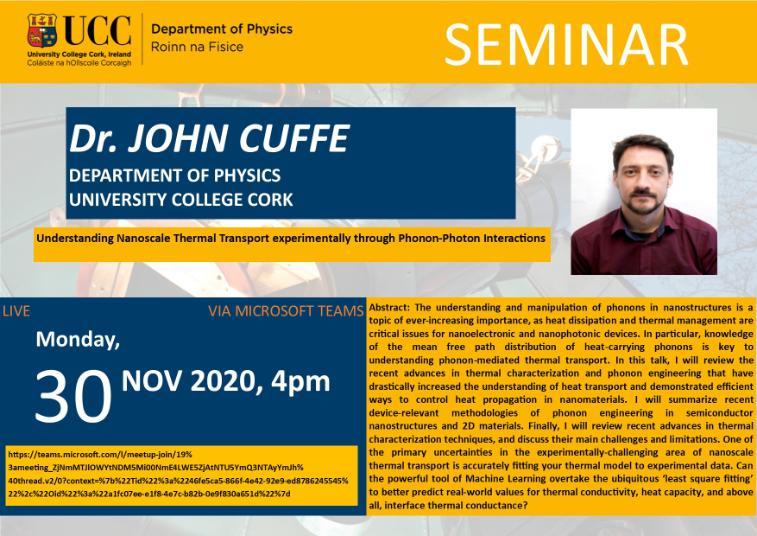
| Seminar Speaker: | Dr. John Cuffe |
| Venue: | Online via MS Teams https://teams.microsoft.com/l/meetup-join/19%3ameeting_ZjNmMTJlOWYtNDM5Mi00NmE4LWE5ZjAtNTU5YmQ3NTAyYmJh%40thread.v2/0?context=%7b%22Tid%22%3a%2246fe5ca5-866f-4e42-92e9-ed8786245545%22%2c%22Oid%22%3a%22a1fc07ee-e1f8-4e7c-b82b-0e9f830a651d%22%7d |
| Date and Time: | 30th November 2020, 4pm |
| Seminar Title: | Understanding Nanoscale Thermal Transport experimentally through Phonon-Photon Interactions |
| Abstract: The understanding and manipulation of phonons in nanostructures is a topic of ever-increasing importance, as heat dissipation and thermal management are critical issues for nanoelectronic and nanophotonic devices. In particular, knowledge of the mean free path distribution of heat-carrying phonons is key to understanding phonon-mediated thermal transport. In this talk, I will review the recent advances in thermal characterization and phonon engineering that have drastically increased the understanding of heat transport and demonstrated efficient ways to control heat propagation in nanomaterials. I will summarize recent device-relevant methodologies of phonon engineering in semiconductor nanostructures and 2D materials. Finally, I will review recent advances in thermal characterization techniques, and discuss their main challenges and limitations. One of the primary uncertainties in the experimentally-challenging area of nanoscale thermal transport is accurately fitting your thermal model to experimental data. Can the powerful tool of Machine Learning overtake the ubiquitous ‘least square fitting’ to better predict real-world values for thermal conductivity, heat capacity, and above all, interface thermal conductance? |
|
9th November 2020
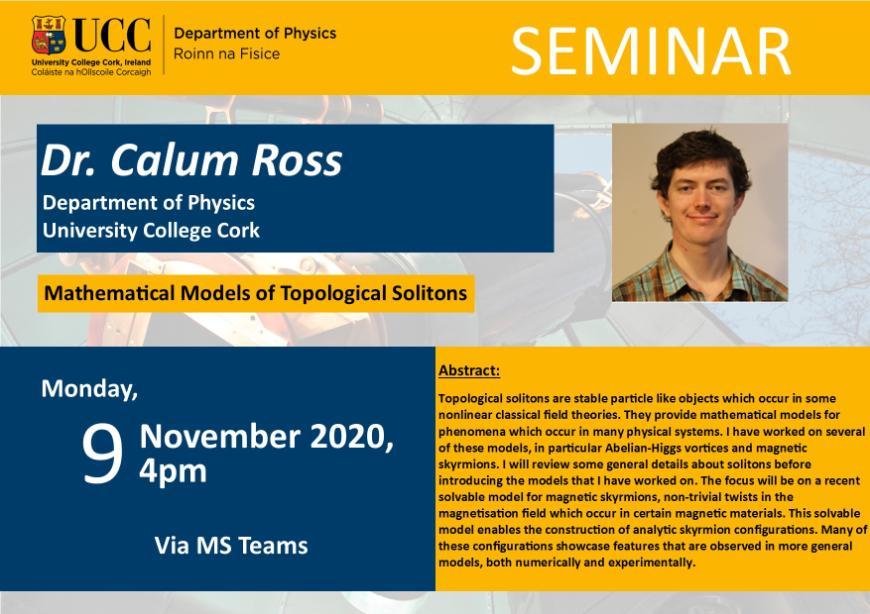
| Seminar Speaker: | Dr. Calum Ross |
| Venue: | |
| Date and Time: | 9th November 2020, 4pm |
| Seminar Title: | Mathematical Models of Topological Solitons |
| Abstract: |
|
19th October 2020
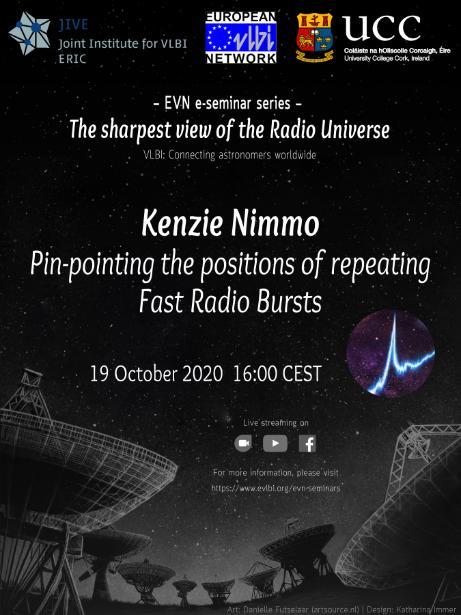
| Seminar Speaker: | Kenzie Nimmo |
| Venue: | Online via Zoom |
| Date and Time: | 19th October 2020, 3pm (Irish Time) |
| Seminar Title: | Pin-pointing the positions of repeating Fast Radio Bursts with the European VLBI Network |
| Abstract:
|
|

